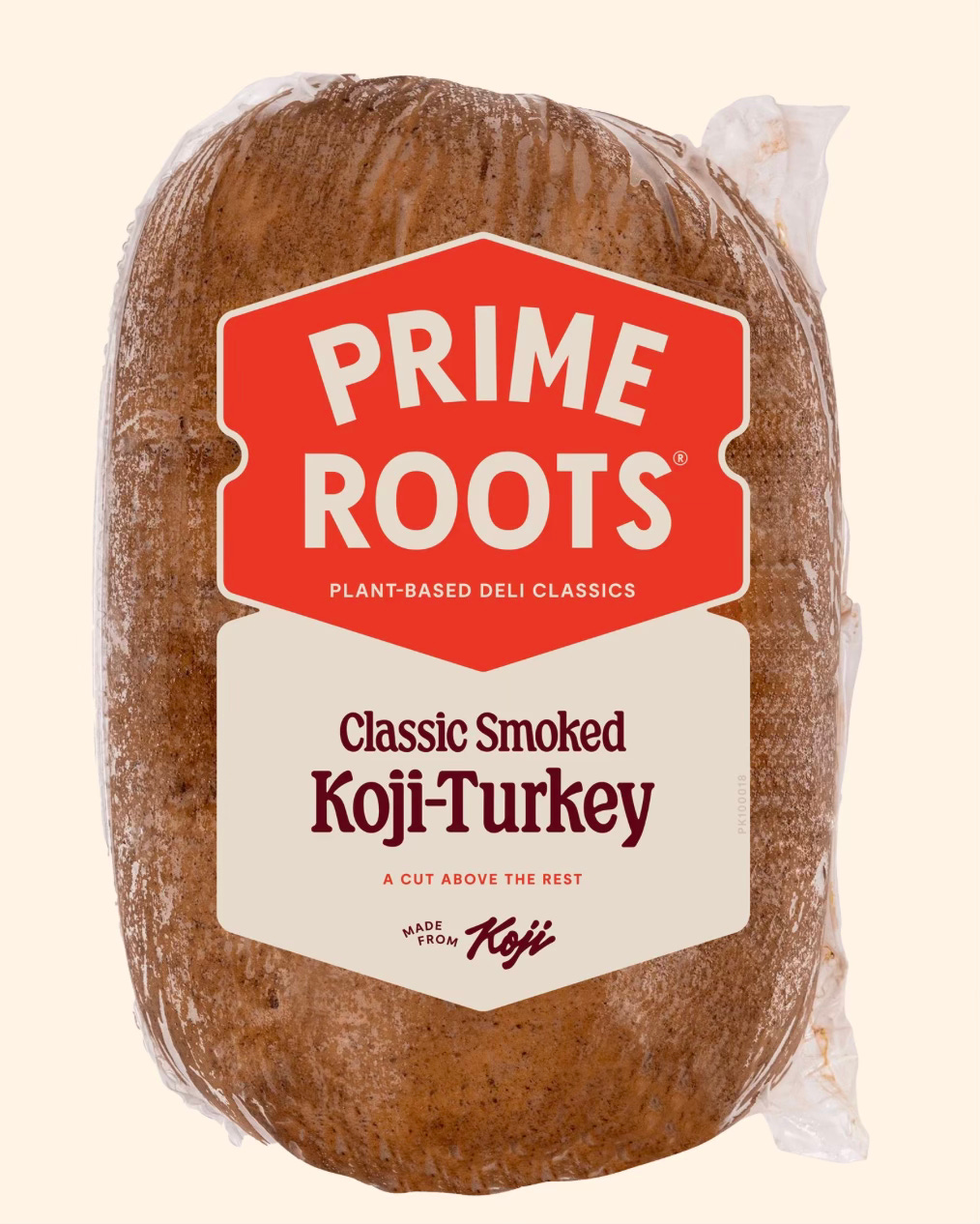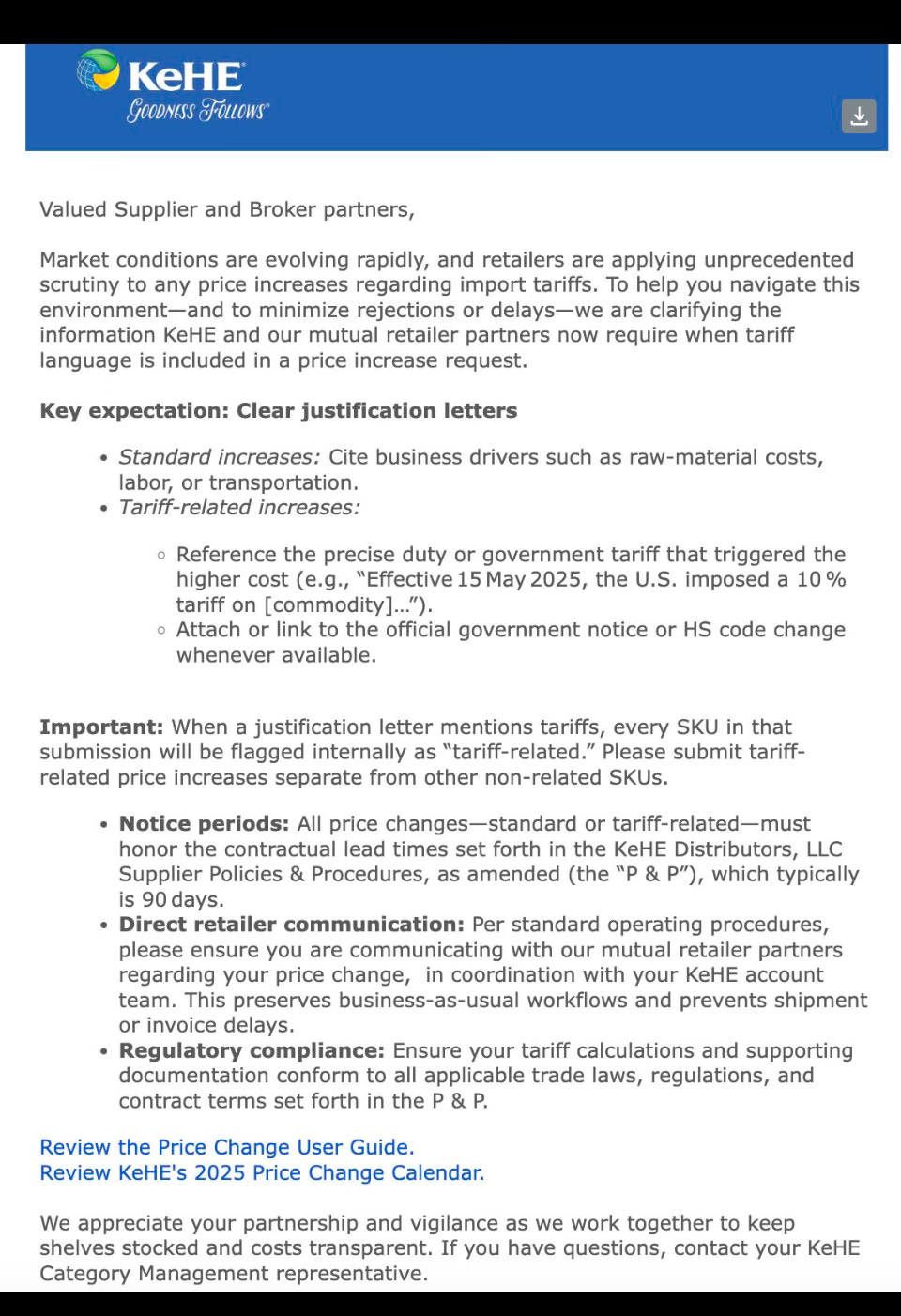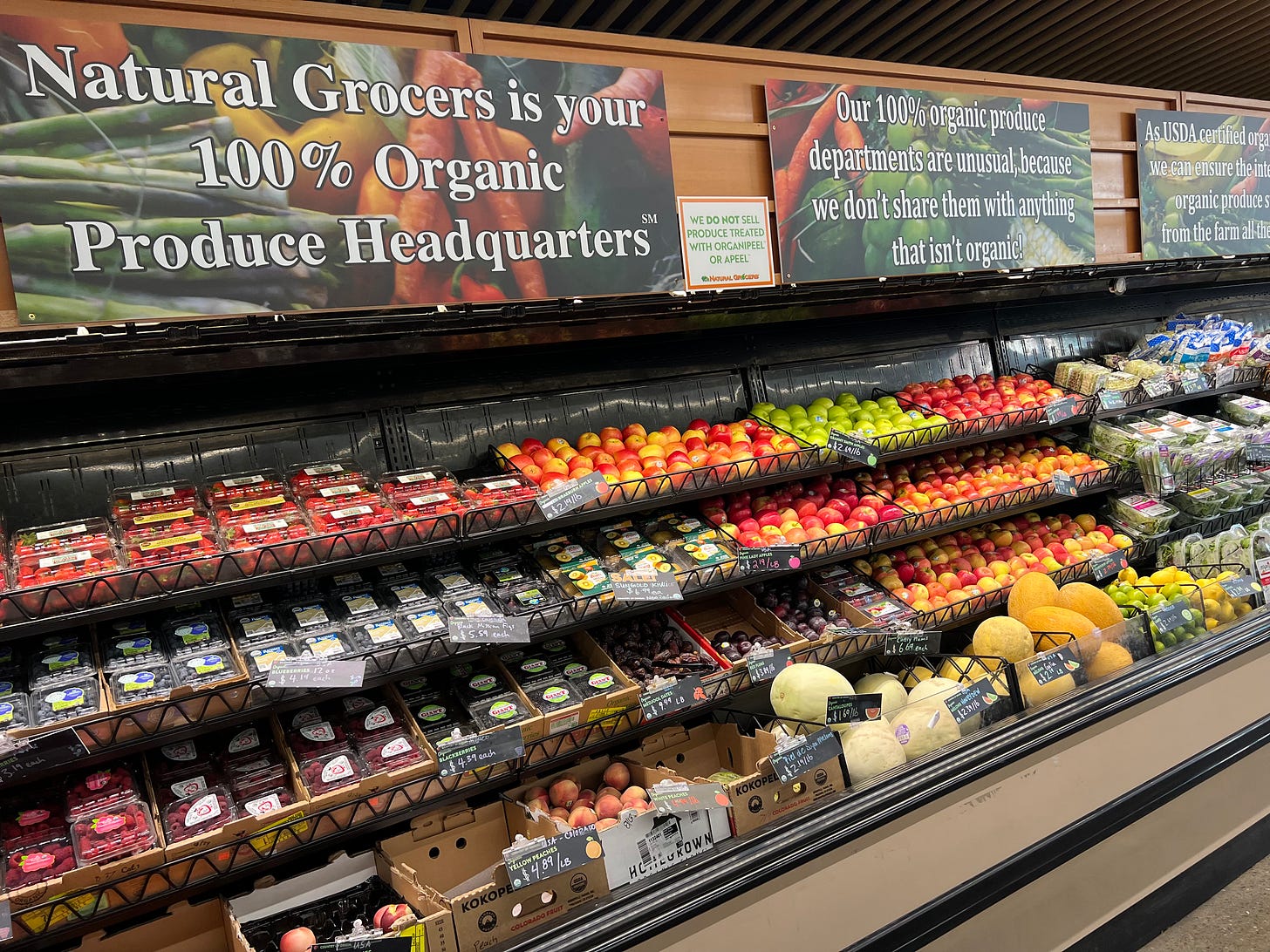Grocery Update Volume 2, #2: Market Insights on Natural Grocers.
Also: KeHe Wholesale’s Letter to Suppliers on Tariffs.
Discontents: 1. Four Questions with Kimberlie Le, Co-Founder of Prime Roots. 2. KeHe Wholesale’s Letter to Suppliers on Tariffs. 3. Market Insights: Natural Grocers.
Welcome to this week’s edition of The Checkout Grocery Update. This week we roll out a semi-regular new feature called Market Insights, a deep dive into the business models of popular grocers. This week’s feature is on Natural Grocers. Coming soon, we will have similar analyses on Whole Foods, Sprouts and more!
1. Four Questions with Kimberlie Le, Co-Founder of Prime Roots.
What inspired Prime Roots?
At Prime Roots, we believe our food shouldn’t be harming us. Sandwiches are one of the most beloved foods in America—over 300 million are consumed every day—and yet the meats we put between our bread are often filled with cancer-causing chemicals like nitrates. I wanted to create clean, better-for-you options that deliver on taste, without compromising our health or the planet. As the daughter of a chef, it was important to me that our products could pass the ‘mom test’ and be something that chefs would be proud to put on their menus. Prime Roots is a mission- and impact-driven company at its core, and we’re committed to building a future where people can enjoy the foods they love without the hidden consequences.
How is your sourcing and product formulation distinct from other products in the category?
Our approach is fundamentally different. We don’t use processed soy, gluten, or ultra-processed plant proteins. Instead, we start with whole food proteins from mycelium—natural fungi—that give our products their incredible meaty taste and texture. We use clean, recognizable ingredients that you can pronounce, and being plant-based allows us to eliminate preservatives, nitrates, and cholesterol altogether. Prime Roots is proud to offer a true no-compromise option—something both meat eaters and plant lovers can get excited about. It’s clean food that delivers the real deli experience.
What challenges have you experienced getting and staying on shelf?
As a new brand in a very established category, we’ve focused on expanding in a sustainable, strategic way. Our products move through conventional distribution channels, and we’re methodical about building where we have the right infrastructure to support success. After two strong years of regional expansion—with some incredible success stories along the way—we’re excited to build on that foundation and expand nationally in the coming year. It’s about growing the right way, ensuring product quality, and setting our partners up for long-term success.
What is your vision for the food system?
I believe our food system should be nourishing both people and the planet. It’s encouraging to see growing awareness around what we’re putting into our bodies and the long-term impacts of our food choices. But there’s still work to be done. I envision a future where the foods we love are made in ways that sustain our planet and feed a growing population, without harmful chemicals or ingredients we have to second-guess. Food should foster connection, nourishment, and trust. Unfortunately, today that’s not always the case—but at Prime Roots, we’re working every day to build that better future.
2. KeHe Wholesale’s Letter to Suppliers on Tariffs.
3. Market Insights: Natural Grocers.
Natural Grocers is a publicly traded and family owned chain of organic and natural products stores. They have 169 stores in 21 states, all west of the Mississippi, concentrated in Colorado and Texas. Natural Grocers did $1.24 billion in sales in 2024 on modest 30.3% gross margins, with 3.5% net profits, and their most recent comparative store sales growth was nearly 9%, a strong number for such a mature company. They sell around 21,000 items, about half of what most grocers sell, and over 6700 supplements, which is much higher than other grocers. The stores are small, quirky, easy to shop and offer plenty of learnings for investors, other retailers and the brands they stock. There are a lot of reasons why Natural Grocers is winning, and a few key areas of concern. Here is the rundown.
Where Natural Grocers is winning.
The stores are small and easily navigable, typically around 10,000 square feet of selling space. No forced flow, no hidden nooks, no vast foyers or endless aisles. Half the store layout is food. Half the store is household products and health and beauty aids. Produce is up front, all organic, followed dairy and deli, with frozen foods along the wall, and a bank of registers up front with plenty of point of purchase racks. No self checkouts. You can easily find your favorite items, time your trip down to the minute, and be in and out and onto your next task. Such small formats stores are more than a convenience, they are a minor luxury for working adults, especially when shopping for special dietary needs or preferences.
They have a highly rationalized and focused natural and organic packaged foods assortment that makes up over 70% of their sales. Not really local this or that. Maybe a few hot or trendy products, once they have been road tested elsewhere. But the key brands, need to have categories and purchase occasions, with premium and value focused price tiers, are all there and accounted for. Pacific Foods, Amy’s, Hu Chocolates, Dr. Bronner’s, Kettle Chips, Bob’s Red Mill. They know their shopper and they don’t disappoint, nor do they go out of their way to impress.
Their private label assortment is priced low at a high quality, and is growing in sku count and market share. At only 8.6% of sales, they have a lot of room to grow their own brands. Most retailers have private label dollar share of sales at well over 10%, with discounters like Trader Joe’s and Aldi at over 80%. Like much of the grocery industry, they are leaning into private label to attract and retain customers and compete with downstream discounters and mass merchants whose much vaster product assortments and supplier negotiation leverage is enabling them to gobble up more industry market share every year. Private labeling is not innovation, but it means can sell analogous products, control their supply chains and branding, negotiate annual cost and ingredient contracts, make a better margin and market their brand name all over the store, all at once. Their private label is making their brand proposition that much more compelling.
They can open a store pretty much anywhere. They have a low operating budget and a nimble business model. No full service counters or cafes. Centralized purchasing and supply chain. They only schedule a handful of staff per shift, a fraction of their competitors, probably cutting things a bit too close to the bone, but this is why they can run a store in the parking lot of a Kroger or Whole Foods and stay profitable and grow every year. They also focus on the lesser served and rural markets that more premium and higher end grocers won’t touch, like Temple or Fredericksburg, Texas, assuring that healthy products are available at reasonable prices even in out of the way locales.
Their pricing and margin model is also effective, with a regular and compelling promotions program. Produce is all organic and comparable to mainstream conventional grocers in price and assortment. Packaged foods matches or beats other natural, specialty and independent chains. But the magic is in their HABA selection, which takes up half the store and around 30% of their sales. Vast, private label heavy, high quality and highly profitable, bringing in 40-50% or higher margins while staying price competitive, the non-food items punch above their weight to allow their food prices to be so reasonable for the quality.
They have the highest sourcing and quality standards at accessible prices. Only Whole Foods, Thrive Market and some food co-ops and small indies come close to the care and exacting effort that Natural Grocers puts into their sourcing. In terms of percent of sales though, Natural Grocers leads in organic, regenerative and humanely raised products’ share of what they sell. They are the only national chain with 100% organic produce and pasture-raised eggs and dairy as their baseline. They do not sell the factory-farmed “all natural” meat and poultry that forms the bulk of such sales at most natural/organic meat departments. They have taken industry leadership roles when it comes to pollinator health, sustainable seafood, cage-free and free range eggs, supplement manufacturing, GMO labeling and avoidance, palm oil sourcing, and regenerative agriculture, including a partnership with Rodale Institute, as much or moreso than Whole Foods’ heyday. Their household cleaning products standard is an industry best practice and exceeds the Eco-Scale program that Whole Foods long ago developed and buried. They are keen on food sensitivities and allergies and their assortment skus towards this customer base. They do more nutrition education than any other retailer. All while keeping their prices at levels that are not offensive or ridiculous.
Come as you are. There is no other national chain that personifies such a lack of judgement, and quirkiness and individuality. Shopping at higher end organic and specialty stores can be such a scene. The shoppers are too cool, the staff want nothing to do with you, the prices are offensive, the vibes are just off. Just look at the parking lot, the Audis, the Beemers, the Yukon Tahoes. Not at Natural Grocers. You are as likely to see a ‘93 Corolla wagon or ancient Subaru hatchback in the parking lot as you are a Prius or Tesla. Likewise for the shoppers, a mix of blue collar workers looking to eat healthier at affordable prices, progressive and diverse students, young, health-conscious value-seekers and their families, Rastafarians, cosmic cowboys, aging boomers, #MAHA moms and Joe Rogan kettlebell Crossfit bros, as diverse a political spectrum that can coexist peacefully under one patchouli and oat bran smelling roof.
Their rewards program, {N}power, is minimally invasive and offers great deals. Over 80% of their customer transactions involved the program and it is driving sales, transactions, customer retention and store traffic. It is safe to say this app and web-based program easily contributed to a few points in their comparative sales and is helping them keep pace with the Amazon Primes and Kroger rewards programs.
Natural Grocers does a lot of things right, but it’s not all unicorns and rainbows.
While it may always be organic, the produce is not always great. Store to store and month to month, the quality, freshness, assortment, rotation and appearance of the produce can vary widely. Like their packaged food selection, they rarely stock local products and it is mostly large scale, industrial organic. They get their produce from third party wholesalers and this means that while they may have favorable cost plus deals, they cannot manage the supply chain and rotation further upstream. It means that their organic produce may be cost effective for shoppers, it is not always as fresh and ripe as the selection at chains that have their own in house supply chains and warehouses, especially stores that still manage to buy comparable product locally. Wegman’s, HEB and Whole Foods do much better on produce quality and freshness, while small regional chains like Kimberton and PCC hit the sweet spot with organic selection and quality.
On a related topic, they are dependent on UNFI as their primary wholesaler across much of the store. UNFI’s operational efficiencies have varied widely in recent years, as the company bit off more than they could chew by acquiring larger rival Supervalu in order to stay ahead of the Whole Foods/Amazon acquisition and has had some rocky years during and after the Covid-19 pandemic, with an uncertain future. Whole Foods, as their largest customer, controls much of the selection and has priority pickings in many of UNFI’s warehouses that Natural Grocers also buys from. They both have a favorable cost plus markup that is far below the gross margin UNFI needs to operate, meaning as they grow, so do UNFI’s challenges.
Natural Grocers’ reliance on UNFI means in the long term they are also beholden to the whims of Whole Foods and have to work harder to make sure UNFI stocks products they will sell, even while they rely on UNFI to planogram their categories and influence what products they can sell. It also means that suppliers that want to be on the shelves at Natural Grocers have to go through the UNFI gauntlet, including their initial guaranteed sale and 60 day nonpayment window, UNFI promotional discounts such as the off invoice deals that enable them to forward buy large amounts of inventory at a discount and sell that to retailers at regular prices, as well as the manufacturer charge backs that tack an extra markup on the markdowns that the suppliers fund but do not get passed through to retailers, as well as assorted billbacks, deductions and other invoicing difficulties that typically add another 10-15% to the cost of goods of products that suppliers have to absorb, all because UNFI needs to provide their afformentioned cost plus markups to retailers like Whole Foods and Natural Grocers that are well below their cost of doing business. Wholesale is a complex, consolidated mess, and there are few viable alternatives. In the long term, diversifying their wholesale supply chain may be a good idea.
Natural Grocers is not great on labor. Their operating model means they can schedule few clerks and cashiers per shift, each of those employees can be trained to stock shelves or run a cash register, and they rarely need more than one manager per shift per store. There are few other chains with as efficient as a labor model, including Trader Joe’s, Aldi/Lidl, MOM’s Organic Market. It looks great on paper, especially with the employee discounts and perks, but grocers can be stressful and hectic places to work, with loads to be stocked, customers to help and ring up, and various fires to be put out. Like Whole Foods and Sprouts, Natural Grocers is allergic to unions and has played dirty to keep organized labor and collective bargaining agreements out of their business model. Considering that unions are at their highest popularity and approval levels in nearly a century due to their proven track record in building the middle class and making industries more safe and equitable, this union averseness means the company is out of step with customers, especially younger shoppers who lean even higher as pro-union. The wages may be competitive with other retailers and above state and federal minimums, but they are not livable wages and food retailers have been notorious for making staff depend on federal assistance, face food insecurity and homelessness and have few opportunities for upward mobility. Few retailers can guarantee they pay livable wages, and only a handful of grocers end up as frequently cited “top places to work”, like Wegman’s. Working in a grocery store means needing a second or third income-earner in the household.
The attitude to labor also affects their product mix. Unlike Whole Foods and Walmart, Natural Grocers has not signed onto the CIW Fair Food Agreement to stock tomatoes and flowers from farms that are audited and certified through worker-driven social responsibility agreements that have been proven through longitudinal studies to eliminate forced labor, wage theft and sexual violence from farm work. Unlike many co-ops and indies, they do not stock much tropical fruit from fair trade, worker-owned cooperative Equal Exchange. And like other natural products stores, they buy Mary’s Chicken from Pitman Farms, whose facilities are deadly and dangerous for chicken processing workers. They do stock many of the usual fair trade consumer goods that UNFI carries, but that is low hanging fruit for most natural products retailers. Fair labor standards are not ubiquitous across much of their supply chain. This means they are likely stocking plenty of products made by forced and trafficked labor, both imported and domestic, from large scale farms as well as from packaged food companies that profit off of prison labor. They have not put the attention and care into the workforce and labor standards as much as they have for other aspects of their supply chains and their diligence around it is pretty lightweight.
Their small format and balanced mix between HABA and food means they have a basic assortment, but it is not always a complete shop. Their category sets do not go too deep into creative, innovative or culinary trends, nor do they have much focus on developing local and regional suppliers, supply chains or food systems. In many ways, their HABA department is much more comprehensive and a step ahead of much of their competition, but it is under 30% of their sales and does not carry the business as much as food does. Shopping at Natural Grocers regularly can save you money but it usually requires cross shopping elsewhere, either for conventional and mainstream products that fall below their exacting standards, but also for many slower selling natural and organic products that don’t make financial sense for them to squeeze into their narrow aisles and minimalist categories.
Their marketing is creative but limited. The graphics and branding on private label don’t take themselves too seriously, but they can err a bit into the “what are they trippin’ on” territory. It is part of the brand, but isn’t always compelling, especially when so many of the products themselves, and the care they put into their standards, their nutrition programs and their impact on the supply chain, are all best in class. They also do minimal seasonal and event-based marketing. While competing regional and national chains will do large scale promotions for the holidays, transforming the entire store vibe and marketing and stocking most of their endcaps with seasonal items, such a strategy feels more like a “nice to have” than a “need to have” for Natural Grocers, who doesn’t have the labor budgets, shelf or endcap space to do nearly as much, and means they are likely losing out on some of these sales as shoppers fulfill most of their holiday and seasonal product needs elsewhere.
In Conclusion.
Despite these issues, Natural Grocers does many things right and stands out among its peer group. There are few retailers that do better on the issues they do not perform well on, and fewer retailers that do better on the issues where Natural Grocers excels.
The grocer is essentially MAHA (making America healthy again) without the stench of eugenics, a judgmental and authoritarian “survival of the fittest” ideology that has become popular in alternatives health circles, public discourse and political policy.
Why is that? MAHA and RFK Jr’s, heralded arrival in Washington and his staunch populist rhetoric against chronic disease and his handshake deal with the food industry to eliminate artificial colors, have all been irreparably marred by mass layoffs and budget cuts at public health and food safety agencies, criticism of abortion medication as pandering to the anti-choice lobby, attempting to gut SNAP and Medicaid, as well as cutting vital medical and scientific research for cancer and childhood diseases, plus rollbacks of workplace safety, environmental protections and environmental justice initiatives, promises to create an autism registry that has spooked the neurodivergent community, the gutting of the civil liberties of immigrants and political dissidents, cutbacks to local food infrastructure spending, massive subsidies and bailouts to industrial agriculture interests hit hard by the trade war-tariff-shakedown, and the administration’s all-around fetishization of white nationalism and transactional, gangster capitalism. While the #MAHA moms are getting great PR, and lots of promises from RFK, Jr., and natural products companies are rallying to his side, the real world impacts of the administration will not be making America healthier, as much as DOGE isn’t saving the taxpayers much money. It’s a con and quite a trade-off, and makes grocery retail seem quite tame in comparison.
In the midst of this, Natural Grocers proves that a viable, accessible, non-partisan and non-judgmental retail model can provide healthy products at affordable prices anywhere, without the social Darwinism of the Trump regime. Opening 10,000 Natural Grocers could do more to transform the food supply than anything RFK, Jr. is promising, with fewer major red flags. It is unfortunate the chain can only open a handful of new stores every year, while Trump and Co. get to run rampant for the next four years or more. Such is life.
Natural Grocers is not perfect and has some key areas for improvement, but they do a lot of things right. They are geared up to keep growing at a modest clip. They aren’t big enough to shift the entire food supply of the United States, but the small impact they are having is meaningful to the millions of shoppers they service every year. And that’s winning.
peace.










Natural Grocers strict policy of only allowing in brands that can afford the 100% free fill to all stores is cost prohibitive for many small brands & is likely the main reason there is a lack of creativity on the shelf. The CM can't bring in an item even if it checks all the boxes due to the inflexible nature of the policy.